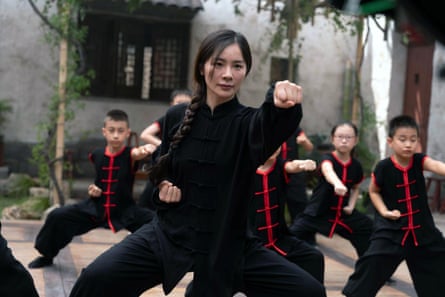Sitges loves its dogs. The pups were out in force this year, sprawling on cafe terraces or getting their poop scooped by conscientious owners, but all of them (happily) were less threatening than the killer mutts on screen at the 58th edition of the International Fantastic film festival of Catalonia, just 25 miles down the coast from Barcelona.
Canine carnage provides the shocking climax to The Virgin of the Quarry Lake, a slow-burn Carrie-esque coming-of-age yarn set amid the economic turmoil of 2001 Argentina. In Todos los Males, set in 1950s Chile, a small boy finds the German half of his family harbours dark secrets (quelle surprise!), one of them involving flesh-ripping hounds. In Shelby Oaks, a woman investigating the disappearance of her sister makes the rookie error of exploring an abandoned prison at night, and finds … vicious dogs! And in the most obviously metaphorical of all, Ion De Sosa’s beguilingly Buñuelian fable Balearic, working-class teenagers are trapped in a swimming pool by a trio of malevolent Belgian malinois dogs while, further up the hill, champagne-swigging poshos fail to notice a forest fire creeping ever nearer.
Conversely, Ben Leonberg’s Good Boy goes some way to restoring confidence in man’s best friend, with a ghost story told entirely from the perspective of a trusty Nova Scotia duck tolling retriever called Indy, who moves with his ailing human into an old dark house in the woods, where the dog senses a malevolent presence his owner does not. But dogs are not the only pets to go rogue. In Jan Kounen’s L’Homme Qui Rétrécit, a respectful and thoroughly enjoyable remake of Jack Arnold’s classic The Incredible Shrinking Man, tiny Jean Dujardin is attacked by Tofou, the family tuxedo cat (brilliantly played by Tchoupi). Kounen, thankfully, favours practical effects over CGI, though nods to modern film convention by having Dujardin puke on screen.
Vomiting in films, once rare, is now an established cliche and provided another of this year’s recurring tropes. It featured in everything from Silencio, three stitched-together episodes of a Spanish lesbian vampire soap opera, to Tornado, John Maclean’s belated follow-up to 2015’s Slow West, in which a Japanese puppeteer’s daughter hijacks stolen gold from a band of ruffians in 18th-century Scotland. With Tim Roth at the head of the miscreants, it’s a terrific setup, but promises more than it delivers.
There is yet more chundering in We Bury the Dead, in which Australian film-maker Zak Hilditch, of These Final Hours fame, puts an intriguing new spin on the zombie film, as the population of Tasmania is wiped out by a US military blunder and Daisy Ridley volunteers to clear corpses in the hope that her missing husband is one of a few cadavers reportedly coming back to life. Alas, Hilditch drops the ball in the third act – though there was plenty of undead action to be had on the streets of Sitges, where the annual Zombie Walk yielded ghoulish visions galore. Pets also go rogue in Primate; this is set in Hawaii, where another bunch of teens is trapped in a swimming-pool, by a rabid chimpanzee with a penchant for ripping off jaws, each fresh display of gruesomeness greeted with cheers by the audience.

Some of the biggest cheers, however, were reserved for action films. In the martial arts-meets-mafia Forbidden City, a Chinese woman searching for her sister in Rome triggers a first-class kitchen fight, making ingenious use of pans, utensils and boiling oil in a way that would do Jackie Chan proud. Even better was Kenji Tanigaki’s The Furious – who cares if the pan-Asian setting is vague, the daughter-gets-kidnapped story is lame and the dialogue is dumb when the film is essentially one long mixed martial arts showdown, with the most thrilling fight choreography since The Raid. And if you think Tom Cruise runs fast, wait until you see Miao Xie sprinting after a truck – in flip-flops!
But my favourite of the festival was a Japanese film: New Group, from Yûta Shimotsu, whose Best Wishes to All screened here two years ago. Ai looks on in alarm as her classmates form a human pyramid in the schoolyard – and that’s just the start of an anti-conformist (and by extension anti-fascist) message expressed in ways that are simultaneously bizarre, funny and disturbing, not a million miles from the surreal visions of horror manga maestro Junji Ito.

.png) 5 hours ago
3
5 hours ago
3

















































